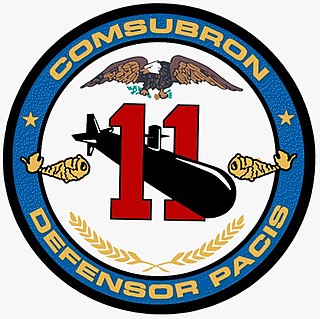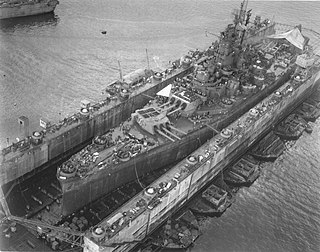Sources
- This article incorporates text from the public domain Dictionary of American Naval Fighting Ships .The entries can be found here and here.
Two ships of the United States Navy have been named Arco for Arco, Idaho.
Arco may refer to:

USS Oak Ridge (ARD-19/ARDM-1) was originally a United States Navy Auxiliary floating drydock suitable for dry docking destroyers, submarines and landing craft, built by the Pacific Bridge Company. In the early 1960s she was upgraded to support Los Angeles-class submarines, and re-classified as ARDM-1-class. A stern door and enclosed bow design allows for open ocean transits. The dock is non-propelled and therefore must be taken under tow to operational areas of the fleet. A steering mechanism with twin rudders is installed to facilitate this operation. Sufficient electrical power was provided by four diesel-driven generator sets to maintain all normal and operational requirements. Living, berthing, and mess facilities are provided for the dock's complement of 5 officers, 10 CPO's and a crew of 186.

USS Artisan (ABSD-1), later redesignated as (AFDB-1), was a ten-section, non-self-propelled, large auxiliary floating drydock of the United States Navy. The only U.S. warship with this name, Artisan was constructed in sections during 1942 and 1943 by the Everett-Pacific Shipbuilding & Dry Dock Company, in Everett, Washington; the Chicago Bridge & Iron Company, in Eureka, California; the Pollock-Stockton Shipbuilding Company, in Stockton, California; and the Chicago Bridge & Iron Company, in Morgan City, Louisiana. This ship was commissioned at Everett, Washington, on 10 May 1943, Captain Andrew R. Mack in command. With all ten sections joined, she was 927 feet long, 28 feet tall, and with an inside clear width of 133 feet 7 inches.

Submarine Squadron 11 is a squadron of submarines based at Point Loma Submarine Base, San Diego, California, United States. Submarine Squadron 11 was commissioned July 1, 1986, aboard her flagship, McKee, at Naval Submarine Base Point Loma, San Diego. Their missions include anti-submarine, anti-surface, strike, special and mine warfare, intelligence, surveillance and reconnaissance. The squadron currently consists of four Los Angeles-class submarines for deployments to the Western Pacific, Indian Ocean and the Persian Gulf.

An Auxiliary repair dock (ARD) is a type of floating drydock employed by the U.S. Navy, especially during World War II. The Navy commissioned 33 ARD vessels: ARD-1 through ARD-33. ARDs were self-sustaining in World War II. ARDs have a rudder to help in tow moving, making ARDs very mobile, and have a bow to cut through waves. ARDs have a stern that can be opened or closed. The stern can be closed with bottom-hinged flap gate, operated by hydraulic rams. This stern gate can be lowered for ship entrance into the submerged dock, and then closed to keep out waves. ARDs were built by the Pacific Bridge Company, in Alameda, California.
USS Endurance is a name used more than once by the U.S. Navy:
Two ships in the United States Navy have been named USS Windsor.

Arco (ARDM-5) is an ARDM-5-class Medium Auxiliary floating drydock for repair and serviced the United States Navy.

USS White Sands (ARD-20), ex-USS ARD-20, ex-USS ARD(BS)-20, later AGDS-1, was a United States Navy auxiliary repair dock in service from 1944 to 1947 and from 1966 to 1974 and an Auxiliary floating drydock.

USS Endurance (ARDM-3) was originally laid down as ARD-18, a non self-propelled United States Navy Auxiliary floating drydock in 1944. Built by the Pacific Bridge Company in Alameda, California. During World War II USS ARD-18 was assigned to the Asiatic-Pacific Theater and serviced ships at Guadalcanal and Ulithi. After the war, floating dry dock ARD-18 was sent to Norfolk Shipbuilding and Drydock Corp.'s yard, circa 1967-68 and was lengthened by adding a 100 ft (30 m) midsection as well as an additional deck above the uppermost crane deck. Redesignated Medium Auxiliary Repair Dry Dock Endurance (ARDM-3), she served until retirement in 1995.

USS ARD-29 was an auxiliary repair dock that served with the United States Navy during World War II as an Auxiliary floating drydock. In 1967, the ship was renamed Arco, and in the 1970s the vessel was first loaned, and later sold, to Iran.

USS Waterford (ARD-5) was an Auxiliary floating drydock that served in the United States Navy during World War II, the Korean War, the Vietnam War, and the Persian Gulf War. She later served the Chilean Navy as Talcahuano (133).

An auxiliary floating drydock is a type of US Navy floating dry dock. Floating dry docks are able to submerge underwater and to be placed under a ship in need of repair below the water line. Water is then pumped out of the floating dry dock, raising the ship out of the water. The ship becomes blocked on the deck of the floating dry dock for repair. Most floating dry docks have no engine and are towed by tugboats to their destinations. Floating dry docks come in different sizes to accommodate varying ship sizes, while large floating dry docks come in sections and can be combined to increase their size and lift power. Ballast pontoon tanks are flooded with water to submerge or pumped dry to raise the ship.

USS AFDM-2 (YFD-4) is an AFDM-3-class medium auxiliary floating drydock built in Mobile, Alabama by the Alabama Drydock and Shipbuilding Company for the U.S. Navy. Originally named USS YFD-4, Yard Floating Dock-4, she operated by Todd Shipyards at New Orleans, Louisiana for the repair of US ships during World War II. YFD-4 was renamed an Auxiliary Floating Dock Medium AFDM-2 in 1945 after the war. USS AFDM-2 was 37 feet (11.3 m) tall, 116 feet (35.4 m) wide, length of 614 feet (187.1 m), and has a displacement of 6,360 tons. AFDM-2 could lift capacity 9,000 tons and had two service cranes to lift material and parts for removing damage parts and the installation of new parts. The floating drydock can repair ships up to a beam of 90 feet (27.4 m), as she is 90 feet wide between the wing walls. Ballast pontoons tanks are flooded with water to submerge or pumped dry to raise the ship. Submerged she can load a ship with a draft up to 20 feet (6.1 m).

ABSD-6 is an advanced base sectional dock which was constructed of nine advance base docks (ABD) sections for the US Navy as an auxiliary floating drydock for World War II. ABSD-6 was built by Mare Island Naval Shipyard at Vallejo, California. ABSD-6 was commissioned on 28 September 1944. Advance Base Sectional Dock-6 was constructed in sections during 1942 and 1943. Each section are 3,850 tons and are 93 feet long each. Each Section had a 165 feet beam, a 75 feet molded depth and had 10,000 tons lifting capacity each. There were 4 ballast compartments in each section. With all nine sections joined, she was 825 feet long, 28 feet tall, and with an inside clear width of 133 feet 7 inches. ABSD-2 had a traveling 15-ton capacity crane with an 85-foot radius and two or more support barges. The two side walls were folded down under tow to reduce wind resistance and lower the center of gravity. ABSD-6 had 6 capstans for pulling, each rated at 24,000 lbf (110,000 N) at 30 ft/min (0.15 m/s), 4 of the capstans were reversible.

USS ABSD-4, later redesignated as AFDB-4, was a nine-section, non-self-propelled, large auxiliary floating drydock of the US Navy. Advance Base Sectional Dock-4 was constructed in sections during 1942 and 1943 by the Mare Island Naval Shipyard in Vallejo, California for World War II. With all ten sections joined, she was 927 feet long, 28 feet tall, and with an inside clear width of 133 feet 7 inches. ABSD-4 had a traveling 15-ton capacity crane with an 85-foot radius and two or more support barges. The two side walls were folded down under tow to reduce wind resistance and lower the center of gravity. ABSD-4 had 6 capstans for pulling, each rated at 24,000 lbf (110,000 N) at 30 ft/min (0.15 m/s), 4 of the capstans were reversible. There were also 4 ballast compartments in each section.

USS ABSD-5, later redesignated as AFDB-5, was a nine-section, non-self-propelled, large auxiliary floating drydock of the US Navy. Advance Base Sectional Dock-5 was constructed in sections during 1943 and 1944 by the Chicago Bridge & Iron Company in Morgan City, Louisiana for World War II. With all nine sections joined, she was 825 feet long, 28 feet tall, and with an inside clear width of 133 feet 7 inches. ABSD-5 had two traveling 15-ton capacity crane with an 85-foot radius and two or more support barges. The two side walls were folded down under tow to reduce wind resistance and lower the center of gravity. ABSD-5 had 6 capstans for pulling, each rated at 24,000 lbf (110,000 N) at 30 ft/min (0.15 m/s), 4 of the capstans were reversible. There were also 4 ballast compartments in each section.

Pacific Bridge Company was a large engineering and construction company. During World War II, Pacific Bridge Company of Alameda, California was selected to build US Navy Auxiliary Repair Docks (ARD) a type of Auxiliary floating drydock and Type B ship barges.